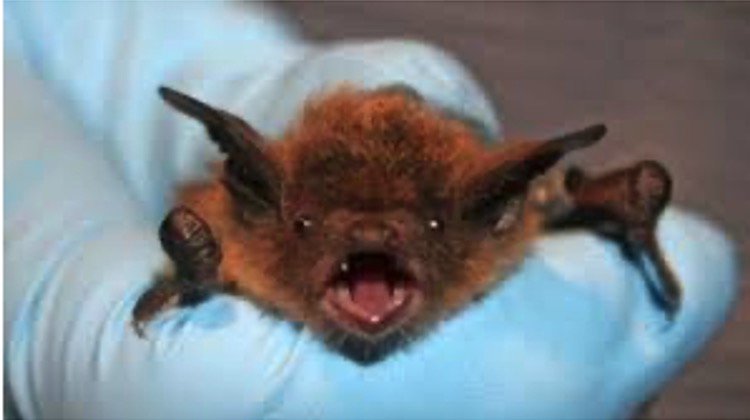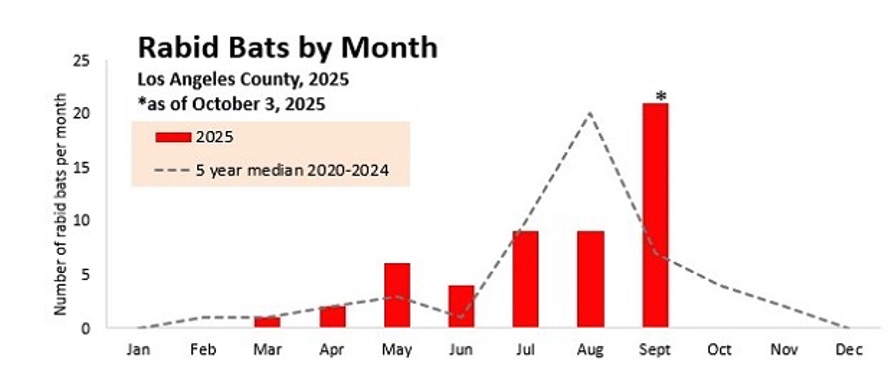Comments
ANIMAL WATCH - “The bats at the La Brea Tar Pits have shed light on one of the ancient animals whose fossils have been pulled from the pools' gooey depths. A couple of those bat species that were uncovered in the tar pits are still alive today and still live in the Southern California area,” said Miguel Ordeñana, a wildlife biologist at the Natural History Museum of Los Angeles County.
“In reality, bats are not rodents, and they play an important role in the ecosystem. They can act as seed dispersers and pollinators. The majorityof bats in Southern California are insectivorous and act as an effective pest control each year.“
In The Night Life: Why We Need Bats All the Time--Not Just on Halloween, he wrote, “Bats live on all continents except Antarctica, and are essential members of many types of ecosystems, ranging from rain forests to deserts,” he added, “They promote biodiversity and support the health of their ecosystems.”
The economic value of bats vs. the dangers
As bats fulfill their ecological roles, they provide many economically important services, the study cites. For example, bats serve as essential pollinators for various types of commercially valuable crops, including bananas, mangos and guavas. Bats consume many crop-eating insects and thereby reduce the need for pesticides.
Additionally, he states, they provide vital ecosystem services; including consuming insects that carry diseases like West Nile virus, and they are important for the health of other natural ecosystems.
“About $24 million dollars would have to be spent on pest control by the agricultural industry if we didn’t have bats," said Paul Stapp, a mammalogist at Cal State Fullerton, in the 2012 study.
BATS AND RABIES DATA IN LOS ANGELES COUNTY
But now, it is 2025, other issues and questions are arising, Los Angeles health officials are warning residents to stay vigilant after they discovered the second-highest number of rabid bats on record this year.
And, LA County Department of Public Health just warned that 61 bats have tested positive for rabies so far in 2025. (The most recorded previously was 68 in 2021.)
“Rabid Bat Danger at Near-Record High in LA County”

Rabies in bats has increased in the past few years in Los Angeles County. The reason behind this increase remains unknown. About 15-20% of bats tested locally have rabies but less than 1% of healthy bats are thought to carry rabies.
. 
|
|
Data based on passive reporting. Reports of sick bats in public or private areas, or bat incidents involving people or animals, are made to local Animal Control agencies. Bats are then collected and tested for rabies. (Los Angeles County began testing bats for rabies in 1961. The data above includes rabid bats from Pasadena and Long Beach.)
“Los Angeles County health officials announced that 61 rabid bats have been detected so far this year, marking the second-highest total ever recorded, just shy of the 68 bats reported in 2021. This figure reinforces a "decade-long upward trend" in rabies cases, with numbers peaking during the late summer.”
The Los Angeles County Department of Public Health noted that approximately 14% of bats coming into contact with people or pets test positive for rabies, a disease that is almost always fatal once symptoms appear.
WHAT CAN WE DO TO BE SAFE?
UPDATE YOUR PETS’ RABIES SHOT—Check with your veterinarian if you are not sure if this is necessary. Office records will provide the last date your pet was vaccinated. Or/ if your pet is licensed, check with your local animal control agency, because your licensing information provides the date of rabies vaccination also.
If you realize you’ve been (or might have been bitten) immediately seek medical care!
ONLY THREE KNOWN-VICTIMS SURVIVED WITHOUT RABIES VACCINE

Woman who was first to recover from rabies without vaccine marks 20th anniversary
According to the Centers for Disease Control and Prevention (CDC), rabies is a zoonotic viral infection most often spread by dogs and wild animals. And in 99% of all cases, when an unvaccinated human catches it, it's fatal. Clearly, though, a 99% fatality rate is not 100% — meaning there are some rare cases when unvaccinated individuals seem to survive rabies either with inadequate vaccination or with minimal medical intervention. In the U.S., alone, there have only been three known such instances, ABC News reported in 2011.
Regardless of how these lucky individuals lived through and after rabies, medical specialists still say vaccines are the best line of defense. Here's a closer look at just a few of the amazing stories of how rabies-infected people beat the odds and survived (via Scientific American).
In 2004, Jeanna Giese, a 15-year-old Wisconsin teenager, was bitten by a bat she touched outside her church. Her parents cleaned her wound and didn’t notice anything special or serious about the puncture until a few weeks later when she became seriously ill. “Her symptoms and testing provided the information on the severity of the bite and the fact that she by then had definite and serious indications of rabies; including, double vision and vomiting,” according to the report.
“It was too late for post-bite rabies anti-virals, and her prognosis seemed bleak,” the report states.

In 2004, Jeanna Giese was put into a coma in a last-ditch effort to save her life (Jeanna Giese)
“He kind of came up with this idea to put me into a coma to kind of separate my brain and my body and let my own immune system fight off the virus,” Giese said.
As The New York Times reported the year Giese was infected, she was taken to the Children's Hospital of Wisconsin, near Milwaukee, and by that time she was only intermittently conscious and critically ill. As a last resort, “the Milwaukee protocol” — an unproven treatment — was called upon to try and save her life.
A coma was induced and areas of the brain typically targeted by the rabies virus go dormant while the patient's immune system continues to fight, supported by antiviral treatments. The protocol worked and she was the first survivor.
An 8-year-old girl, Precious Reynolds, in California was scratched by a stray cat.

Seven years after Jeanna Giese, in 2011, an 8-year-old girl in California named Precious Reynolds contracted rabies from a minor cat scratch – thought to be a feral cat.
Reynolds was also unvaccinated, and developed her symptoms too late for antiviral treatment. By the time she was transported to UC Davis Children's Hospital, the encephalitis (brain inflammation associated with rabies infection) had developed, according to news accounts.
In both cases, neither of the patients was given rabies-immune globulin--typically administered along with post-infection antiviral treatments. Reynolds was also treated using the Milwaukee protocol, and she survived. Of this second Milwaukee protocol success, Dr. Greg Poland of the Mayo Clinic said (via ABC News), "This is indeed a very, very unusual course of events."
Dr. Rodney Willoughby added (via ABC News), "Whether this is just a natural tendency for an occasional survivor or whether our therapy is providing added value is up for discussion. Some people may be able to survive naturally." Speaking with the Austin-American Statesman, Willoughby said, "We made something up and it worked. Getting it to work again — that's been much harder. Either we're doing something right, or we're just lucky."
A third female victim was a 17-year-old Texas girl, who survived on her own, according to reports, and her identity was withheld. (The patient was a runaway at the time she sought medical treatment, and her name was kept private in the press, the Austin-American Statesman reported in 2012).
In 2009, the teenager indicated she had sought medical treatment and was found to be infected with rabies, the CDC writes. She had come in contact with bats, but was not aware of being bitten. However, once she tested positive for rabies, she was given the standard five post-infection vaccinations. The treatment had to be discontinued; but doctors said, “Inexplicably, she still recovered.”
According to the report, Dr. Charles Rupprecht of the CDC’s rabies program told reporters tat “some humans may just survive rabies like some animals do. (Credit is given to Austin-American Statesmen for this report/ no photos were available.)
Once she tested positive for rabies, she was given the first of five post-infection rabies vaccinations, but the cycle was discontinued for fear it might complicate her immune response. Inexplicably, she still recovered. According to Dr. Charles Rupprecht of the CDC's rabies program, some humans may just survive rabies like some animals do. "Abortive rabies is not unusual in research animals — it happens spontaneously all the time," he said (via the Austin-American Statesman).
Though the Milwaukee protocol seemed to work in at least two cases, infected patients died in other circumstances, and more research is needed. Still, these examples of rabies recovery have spurred a fresh look at the infection.
Dr. Tom Sidwa head of the Texas Health Department rabies program reportedly told the Austin-American Statesman, before the 2009 case in Texas, in particular, "anything that suggested improvement, they said, 'That ain't rabies.' They can't say that anymore."
(See also: Rabies Kills Five Humans in U.S. in 2021, Rabid Bats in L.A. County at Record Level)
(Phyllis M. Daugherty is a former Los Angeles City employee and a long-time animal welfare advocate. A contributor to CityWatchLA, she is known for her investigative reporting on animal shelter operations, misuse of public funds, and the dangers of poorly regulated pet adoption policies. She is a strong proponent of public safety in animal control, advocating for stricter oversight of aggressive dog breeds, especially pit bulls, and for breed-specific legislation.)







